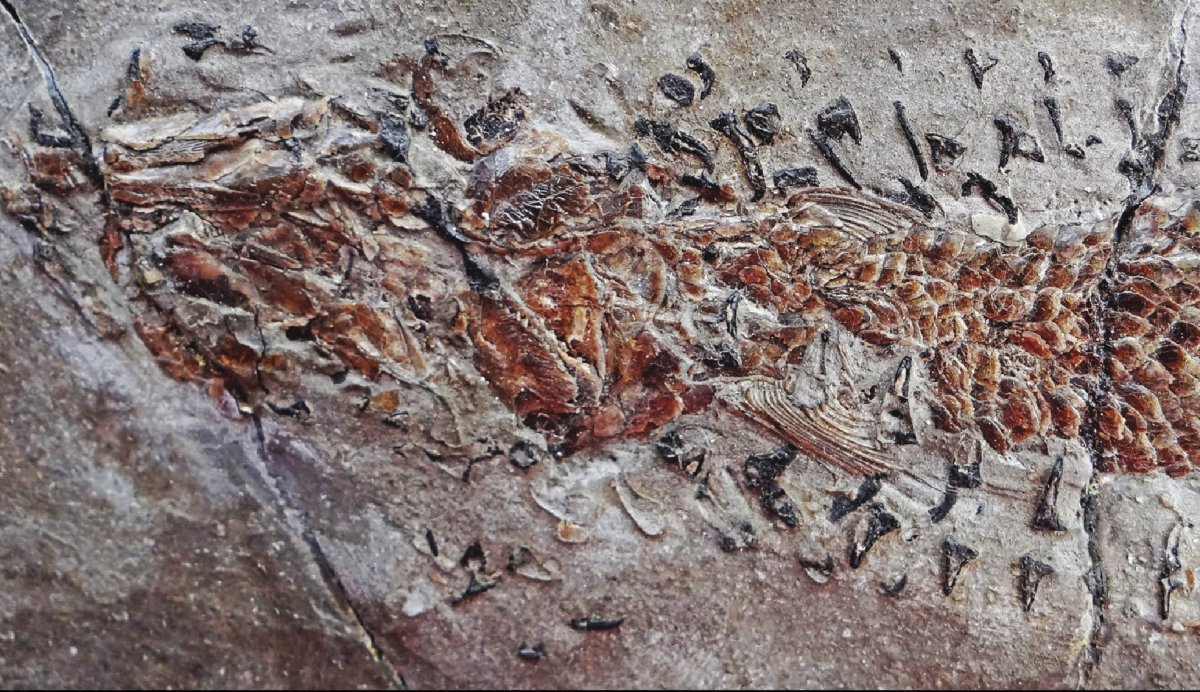A 200-million-year-old fossil from Britain's Jurassic Coast may be the oldest known example of a "squid-like" creature attacking a fish in existence, say scientists at the country's University of Portsmouth.
The creature in question is a species of cephalopod called Clarkeiteuthis montefiorei, an ancestor of today's squid. It appears to have a species of herring-like fish called Dorsetichthys bechei clasped in its jaws.
According to researchers, the position of the cephalopod, whose arms run alongside the body of the fish, suggests it was attempting to feed on the creature. As such, the fossil offers a rare snapshot in time of a predator attacking its prey.
Lead author Professor Malcolm Hart, emeritus professor at Plymouth, describes the specimen as "a most unusual if not extraordinary fossil." Predation events like these occur only occasionally on the record.
"It points to a particularly violent attack which ultimately appears to have caused the death, and subsequent preservation, of both animals," Hart said in a statement.
Hart told Newsweek: "This seems to be the earliest example of squid-fish predation, and had been in the collections in London, then Keyworth, since the 1870s." He describes the find as "fortuitous."

"I was going through some new material in a private collection, and was told that this specimen was on loan to Lyme Regis Museum," he said. "I recognized it immediately for what was there—the ink sack of the squid—and the fish being held by the arms of the squid. The previous week I had been looking at a paper that mentioned the 'oldest' known example of such predation—and here I was looking at something a few millions of years older."
He added: "To see a daily event [from] 190 million years ago just seems fascinating."

Hart suspects it could be the oldest specimen of its kind, dating back to the Sinemurian period 190 million to 199 million years ago. If these suspicions are confirmed, he says, it makes the fossil at least 10 million years older than other cephalopod fossils in attack mode.
The fossil in question was discovered on the Jurassic coast back in the late 19th century. The area—a 95-mile stretch of coastline and UNESCO world heritage site—is an important area for Mesozoic Era (250 to 65 million years ago) relics, containing dinosaur bones as well as the remains of Jurassic-era mammals and sea life. This particular fossil was discovered in the nineteenth century.
"This fossil has been in the collections of the British Geological Society for a long time—I remember seeing this fossil when working on my undergraduate degree thesis," said Thomas Clements, from the School of Geography, Earth and Environmental Sciences at the University of Birmingham, U.K., who was not involved in the research. "The fossil itself is wonderful but beyond that this paper does not add much to our current understanding.
"Fossils that show the interaction between predators and prey are very rare— but other examples of this exact species of belemnoid having captured fish during the last moments of their life are known and written about in the literature," he told Newsweek. "The fossil does show that potentially, some belemnoid cephalopods had eyes too big for their belly!"

The researchers have put forward two hypotheses to explain how the cephalopod and fish ended up in this particular conundrum that has bound them together for hundreds of millions of years.
The first is that the cephalopod took off more than it could chew and the fish got stuck between its jaws. The two creatures sank to the seafloor together and dead, and were preserved there, resulting in the fossil we have today. The second is that the cephalopod deliberately took its prey to the seafloor to escape the attention of another predator but inadvertently stumbled into waters with low levels of oxygen and suffocated as a result, before being preserved.
The research was presented as part of Sharing Geoscience Online, which will be taking place virtually instead of the European Geosciences Union's (EGU) annual General Assembly. It has been accepted for publication in the journal Proceedings of the Geologists' Association.
Uncommon Knowledge
Newsweek is committed to challenging conventional wisdom and finding connections in the search for common ground.
Newsweek is committed to challenging conventional wisdom and finding connections in the search for common ground.
About the writer
To read how Newsweek uses AI as a newsroom tool, Click here.








